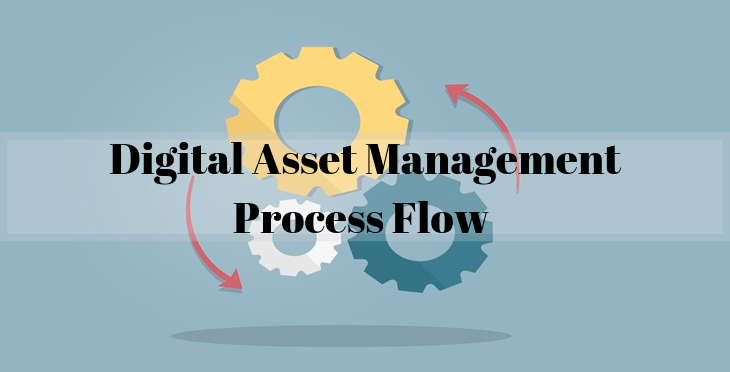Before going into digital asset management, let’s first understand digital assets. Digital assets are files like photos, videos, logos, products’ images, audio, animations, creative files, presentations, and other media related files.
For some organizations, these are just not ordinary files but are the most valuable assets. And, it is for the maintenance of these files under one roof that digital asset management tools are required.
DAM is a system which which stores, organizes, shares, retrieves, manages digital rights and grants permission for your digital assets.
It acts as an arsenal of rich media files, which require a little bit of more care and security.
In this next step, let’s dig deep into the digital asset management workflow to understand the complete process from its root.
Digital assets require encoding and decoding for creation. To create a product in the DAM system, data objects must be brought into the digital domain first.
Anyways, DAM tools and their supporting systems provide a numerous amount of services to create digital files by ingesting content and graphical user interface.
Content creation also marks as the first step in the process flow of the DAM.
DAM systems also enhance your media files with metadata. So, that you can name your file (title), along with its description, modification dates, locations, original creation date, size of the file, encoding, packaging, access rights, etc.
This process is also known as metadata management.
This feature provides leverage to users. Let's understand this by an example.
If you create a new asset in the DAM tool, then most of the metadata fields are filled automatically like creation date, access right, encoding, file size, temporary locations, space utilized on disk or cloud, etc. Other fields can be filled by the user, or they can also take help from external applications.
DAM also provides multiple versions of the same asset. Users can create multiple versions of the same asset and store them by the same name as well.
The system automatically arranges these files as per their file type.
For example, if you create a video on DAM tool, the system will allow you to create its different versions like high quality, medium quality and low quality along with different media types like MP4, 3GP, OGG, WMV, WEBM, etc.
These files can be stored, both online as well as offline. Most of the media files require a large space in the database because of rich media files being generally heavier in nature.
In these cases, extra storage devices like hard drives or cloud space are often required. DAM tools prove to be useful here as they provide their own in-built storage space.
Today, most of the know DAM providers provide extra space to users because they understand and analyze the situation of heavy file storage.
This is a feature related to search which allows us to sort files, for convenience purpose.
Here, exists a pyramid-like folder structure where a user can drag and drop the files from one folder to another.
As I explained to you in the introduction, DAM tools provide us with the ease of organizing files and data. Indexing of the content is also a part of the data organization.
The indexing feature consists of a search bar that helps to provide data and files to a user within a fraction of seconds.
Suppose you are looking for animation files in the database, you just need to type animation in the search bar, and names of all the animation files will appear in the suggestion box.
These suggestions are based on your previous searches and titles of saved files in the database.
DAM system provides access control and user management. Every DAM system provides internal security to your digital assets.
Access control is a key feature of the DAM tool, and an administrator acts as an in-charge of the system. An administrator is the only person who can give access to other users.
DAM provides us with delivery features so that they can deliver their content to the right channels and clients. It’s a hassle-free experience for a user.
This feature is also capable of measuring content consumption.
For example, you share your data with the client on their cloud portal via the DAM tool.
Once your client opens that folder, their activities will get automatically recorded in your DAM portal - log files.
Along with this, users can also get data in the form of reporting, data visualization, and embedded business intelligence.
Once you post your asset online, measuring its performance should be your next and probably the final step. DAM provides you with tracking and monitoring performances of your digital assets.
Suppose you choose social media, emails, and mobile channels to promote your assets, in this case, the DAM analytics feature gives you the flexibility to monitor customer engagement on all the platforms.
You will receive an analytics report in the form of pivot charts, graphs, and numbers for easy understanding.
Now let’s have a look at some best practices for choosing a DAM solution for your organization.
A DAM system should be considered a failure if it's not capable of finding your digital assets.
While choosing a DAM tool, you should always look for its searching & indexing capabilities.
A DAM system should be flexible and must support flexible metadata schemes. This will help you make a varied number of enhancements to your media file.
A DAM system must be capable of adaptability. Let’s suppose your system is designed on .Net.
So, in this case, your DAM should not ask for .Net compatible files for installation or any other activity. It should be able to support any language.
Your DAM system should be capable of distributing work to your teammates and subordinates.
An administrator usually has the authority to distribute the work. Only an administrator can share the work through the DAM tool on various platforms like emails, social media, etc.
This could be an overwhelming feature but should be considered as a topmost priority while you are choosing a DAM tool for your company.
Nowadays, analytics has been a necessity for any business and the tools that they’re using. For analyzing the performance of your digital assets, a beforehand check for in-depth analytics is a must.
A good analytics feature covers every minute details of your projects like; who has been accessing your digital asset files? On which platforms are your assets getting published? Who is uploading assets on the tool? Who downloaded those assets? Which of your assets are modified or in production or ready to use?
Along with this, your DAM tool should deliver a wide range of reports.
Going through the entire workflow of a DAM tool will certainly help you with refining your process and also on what parameters a tool should be selected.
You May Also Like to Read:





